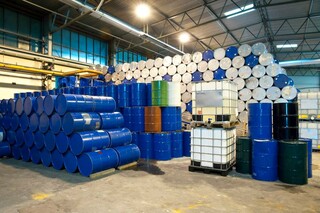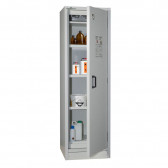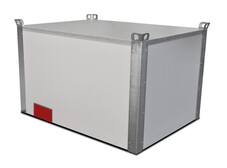In a great many places in Poland, both when it comes to business and various types of institutions, hazardous and flammable substances are used, stored and kept (e.g. in industrial plants, laboratories, workshops, but also in less obvious places such as restaurants or hotels). The correct storage of such materials is one of the key issues to ensure the safety, first and foremost, of employees, but also to protect the environment and meet legal requirements. It is also important to bear in mind the safety of the building or site itself where these substances are stored and the accompanying infrastructure.
The storage of flammable substances is a very broad topic and extremely relevant at all times, but recent reports related to the numerous fires that break out in our country prompt us to refresh the topic and emphasise how important it is to secure and store flammable and hazardous substances in business properly.
Flammable and hazardous substances – characteristics of materials that should be stored in cabinets
The chemicals we consider hazardous are both liquids, gases and solids that can pose a risk to the health or safety of employees. Interestingly – they are found in most workplaces. Hence, a great many workers come into contact with chemical and biological substances that can harm and endanger their health and even their lives.
Hazardous materials are substances that can pose a risk to human health and safety or the environment. They can be toxic, corrosive, reactive or radioactive chemicals. Flammable materials are those that can ignite and include solvents, petrol, alcohols and other chemicals with a low flash point.
Flammable and hazardous substances are numerous. The way in which hazardous substances must be stored should be indicated on the safety data sheet accompanying the substance and is determined by a number of factors. Decisions on what agents should be stored in cabinets are made by the employer (environmental protection, health and safety department) taking the data on the SDS into account, as well as the safety of the workers and the workplace.
What types of safety cabinets are there?
There are various types of safety cabinets available from Hartmann Tresore, which are tailored to the storage and containment of hazardous and chemical substances. These include:
• environmental cabinets,
• cabinets for chemicals, poisons, toxic substances,
• cupboards for acids and bases,
• combination cabinets, so-called split cabinets, in which different types of substances that cannot be stored together can be kept. Such cabinets have separate compartments for different product groups.
• gas cylinder cabinets,
• explosion-proof cabinets,
• cabinets for storing Li-Ion batteries,
• hazardous and flammable material cabinets, type 30 and type 90 – these are the main focus of this article.
The main difference between safety cabinets lies in their structure, the materials used in their construction and their designation (depending on the substances stored in them).
Cabinets for hazardous and flammable materials – key features
The choice of the type of cabinet is extremely important to ensure safety, both for the personnel and for the workplace as a whole. Above all, cabinets for hazardous and flammable materials are characterised by their fire resistance – this can be 30 or 90 minutes.
Other key features of hazardous and flammable material cabinets include:
• fire-resistant construction: the safety cabinet is made of high-quality non-combustible materials, and additional insulation in the body protects against excessive temperature increases inside the cabinet.
• ventilation systems: the cabinets are equipped with ventilation openings with mechanical or automatic closures that will operate in the event of a fire.
• shelves and drip trays: the shelves are adjustable and the drip tray located at the bottom of the cabinet collects spilled liquids and prevents them from spilling outside the cabinet.
• closing mechanisms: special solutions are used in the cabinets to ensure that the doors close automatically in an emergency, i.e. when a fire is detected.
• clearances in the base of the cupboard, making it easier to transport the cupboard from place to place.
The importance of hazardous material cabinets
Hazardous and flammable material cabinets serve to store these substances safely, minimising the risk of explosion, fire or leakage. Here are the main functions of such cabinets:
• protection against fire: these cabinets are designed to withstand high temperatures for a specific period of time (e.g. 30 or 90 minutes), allowing time for the evacuation of workers and the intervention of the fire brigade.
• isolation from heat sources: the design of the cabinets prevents heat from the outside from entering the interior, which is crucial in the event of a fire in the room.
• access restriction: the cabinets are fitted with locks and security mechanisms to prevent unauthorised access, which is important to prevent unapproved use or theft of dangerous substances.
• safe working environment: the interior of the cabinet is designed (sump tray) to minimise the risk of leakage or accidental mixing of different types of substances.
We also recommend other texts from our blog:
Cabinets for flammable materials. What does the market offer?
Social Security subsidy for the purchase of cabinets for hazardous and flammable materials
Flammable cabinets – where else are they used?
In addition to the obvious places (factories, businesses, manufacturing companies), flammable cabinets are also used in other, less obvious places such as restaurants and hotels. Here, extremely dangerous and hazardous substances are, for example, heater fuels and gas cylinders.
We were recently approached by a major restaurant chain for help in selecting a fuel storage cabinet. Each restaurant takes its own care of the green areas around the restaurant in summer and cleared pavements in winter, and fuel for lawnmowers or diesel snowblowers needs to be well secured, due to the risk of fire.
Summary
Hazardous and flammable material cabinets are an important part of risk management in workplaces where such substances are used, stored and kept. Proper storage of hazardous and flammable substances, in compliance with the regulations, ensures safety, protects people's health and lives, but also safeguards against property damage and financial penalties.
Compliance with safety standards for the storage of hazardous substances, as well as regular inspections and audits, are key to maintaining a secure workplace environment.





